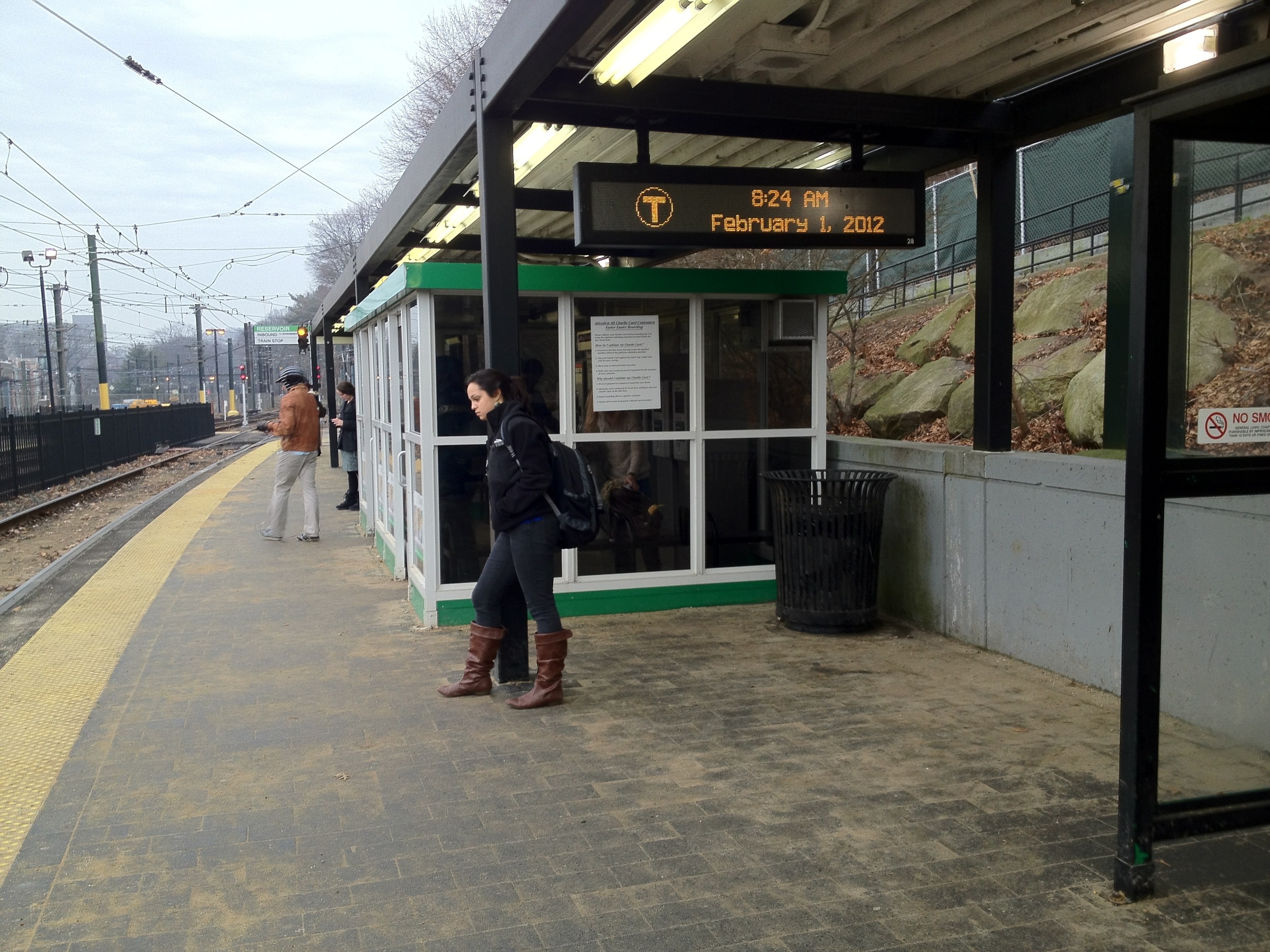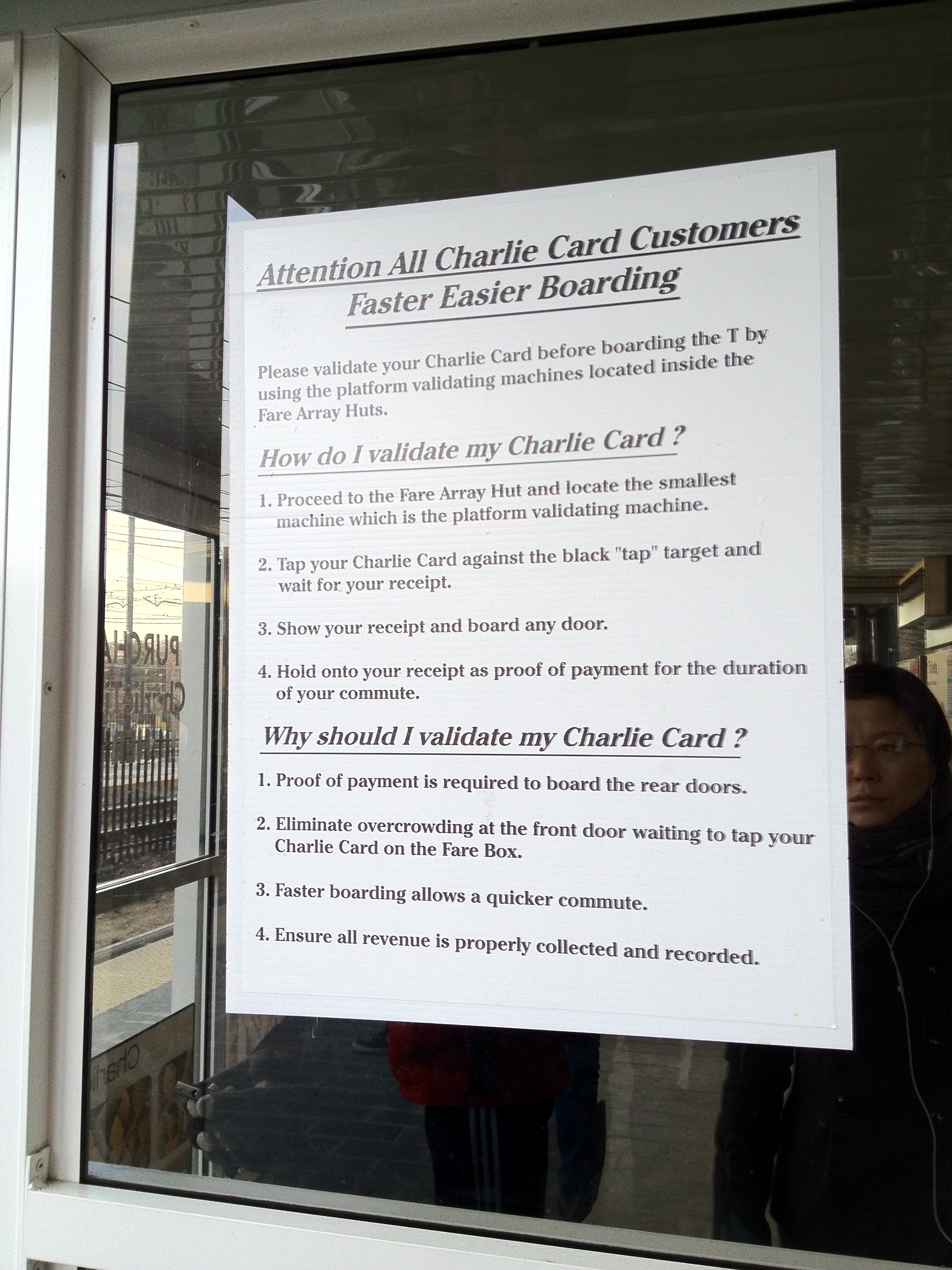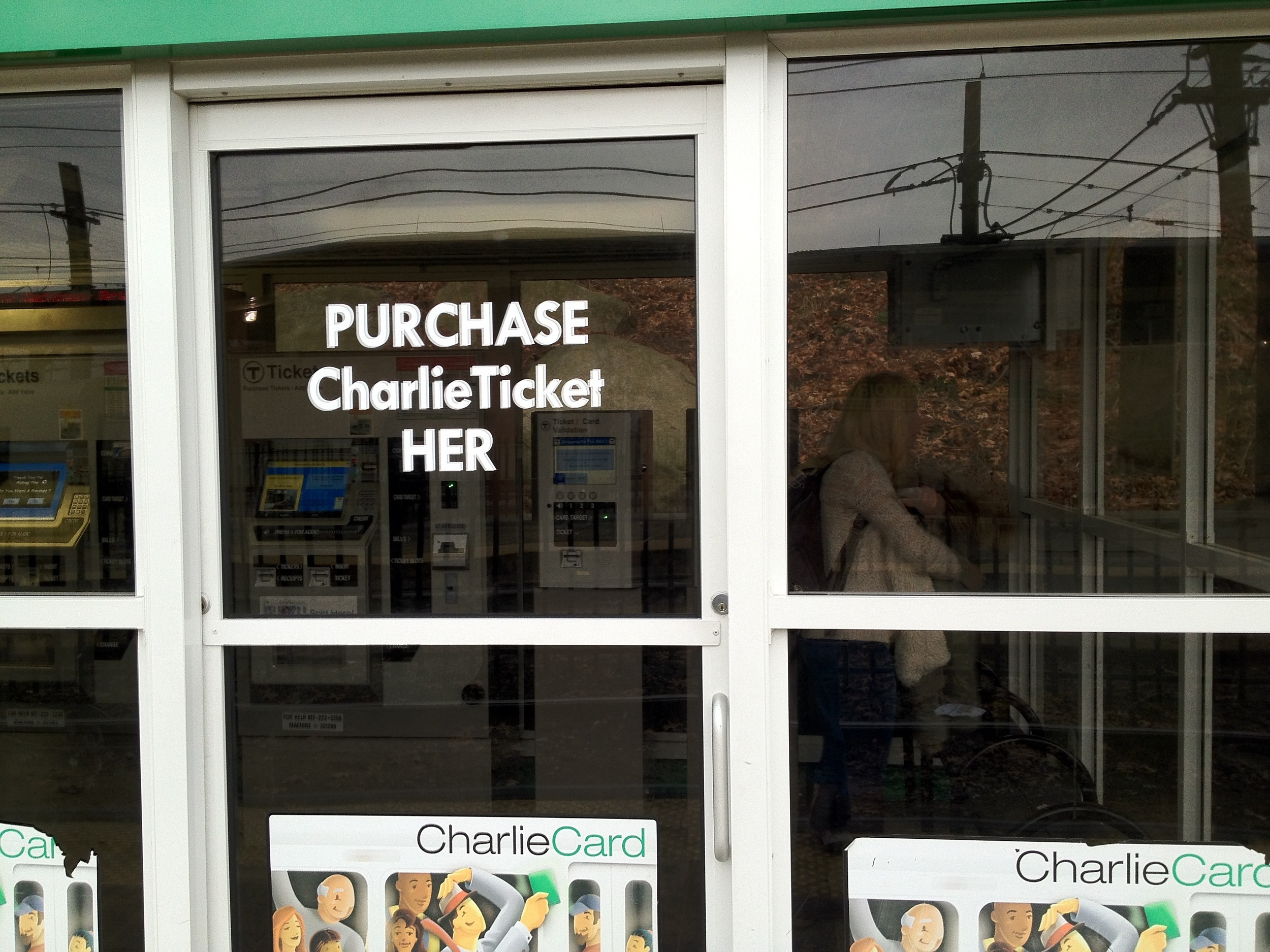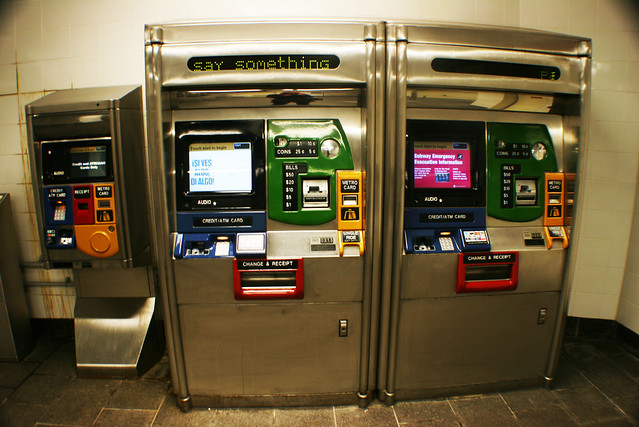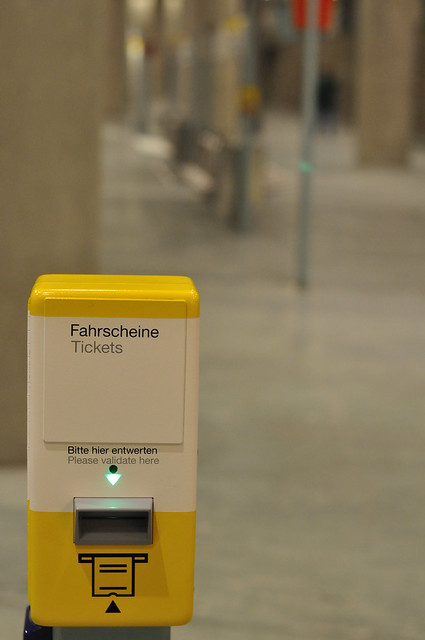
Podcast 22 - MBTA Raising Fares Again, Overtime Lies, Challenges and Opportunities
The MBTA fare increase proposals (presentation, summary) are unnecessary and not even helpful in closing the budget gap. This is the latest example to the way the Fiscal & Management Control Board is using misleading statistics to support an ideological agenda that has never worked. What happened to being visionary and taking a fresh look?
Short of major investment -- which is needed more than ever -- many simple changes could improve the user experience and help alleviate capacity constraints. For example:
- The transfer policy could allow unlimited use within 2 hours (instead of the current one-transfer limit) to offer new options for shorter trips, increase ridership, reduce congestion downtown and save money.
- All-door boarding on buses and trolleys means faster trips, more frequent service, lower fare evasion and operating cost savings.
- Expanding Zone 1A on Commuter Rail to all Boston stations as well as Waltham and Lynn would offer fast service for thousands of low-income riders while reducing operating costs.
- Many low-cost changes such as upgrading bus stops, stations and terminals would improve service quality and increase ridership.
UPDATE: See our Fares & Service fact sheet (the longer version is here).
All this and more in this week's show, recorded in the WMBR studio at MIT in Cambridge. Marc offers some insights from this year's TransportationCamp DC on how regional governance could address some of our management challenges, and former T General Manager Beverly Scott was there. We hear a little bit from the growing transit advocacy network, as organizations like TransitMatters start to pop up in cities across the country.
The Transit Matters Podcast is your source for transportation news, analysis, interviews with transit advocates and more. By offering new perspectives, uniting transit advocates and promoting a level of critical analysis normally absent from other media, we can achieve a useful and effective transportation network because Transit Matters.
Like what you hear? Share it around, tell your friends and colleagues, and subscribe to the blog and podcast (on iTunes) to be notified of new posts and episodes. Support our work by becoming a member, making a donation or signing up to volunteer because we can't do this alone. Let us know what you think by connect with TransitMatters on Facebook or Twitter. Follow Jeremy Mendelson @Critical Transit, Josh Fairchild @hatchback31, Jarred Johnson at @jarjoh, Marc Ebuña at @DigitalSciGuy, and or email us here.
Green Line Update Teases Improvements Enabled by Tracking Technology
Back in June, I had the pleasure of attending a forum on Green Line issues hosted by the MBTA and facilitated greatly by Senator Brownsberger. The presentation included updates on the primary issues afflicting the Green Line and its dependent riders as outlined by Brian Kane, MBTA Director of Policy, Performance Management & Process Re-Engineering and former budget analyst with the MBTA Advisory Board.
As a corollary to our guest contributor post on the disappointing improvements and issues with Commonwealth Avenue, we have a few (much delayed) updates about the T's more progressive plans to improve transit along the corridor.
Back in June, I had the pleasure of attending a forum on Green Line issues hosted by the MBTA and facilitated greatly by Senator Brownsberger. The presentation included updates on the primary issues afflicting the Green Line and its dependent riders as outlined by Brian Kane, MBTA Director of Policy, Performance Management & Process Re-Engineering and former budget analyst with the MBTA Advisory Board.
Others present at the meeting included leading MBTA staff that Dr. Scott heralded as subject matter experts to ensure questions could be answered directly by the most appropriate person from the agency. Top MBTA management included:
Dominick Tribone for questions on information systems
Bill McClellan, Director of Green Line Operations
Laura Brelsford, Deputy Director of System-Wide Accessibility
Melissa Dullea, Director of Planning & Schedules
Mr. Kane broke down the issues into 5 key areas and highlighted the improvements the T is aiming to tackle over the long run.
Speed
The biggest hindrances to speed right now are the incredible closeness of stops on some lines, the lack of signal preemption, and restrictions from fare collection and public outcry about boarding policies.
At the moment, the C line is the slowest, averaging 11.1km/h (6.9mi/h) with an average stop spacing of about 305m (1000 ft), while the D is the fastest, averaging 30.6km/h (19.5mi/h) with an average stop spacing of about 1.2km (4,000 ft).
Stop Consolidation
The number of stops increases time the train spends either stopped or slower than cruising speed. Even if the volume of passengers stays the same, the math still works out to be that the train spends more time slowing down to stop at each stop. Further, each stop that a train has to make before a stop light increases the chances that the train will miss a number of green cycles and get stuck at a red light. Of course, the real culprit of slow loading times is a capacity issue, which we'll discuss below. Ultimately, the promise is faster train speeds at the compromise of increasing the walking distance for some.
Brian Kane commented that the MBTA has championed stop consolidation before, but the issue is as polarising as the issue of fare collection. A survey in 2005 showed widespread support for stop consolidation while seemingly as many people come out to defend the need for a stop as the people who clamor to remove it. At the moment, there are no plans to make further consolidations, but monies have been issued for a Commonwealth Ave improvement scheme. Dr. Scott underscored the fact that part of the money earmarked for the project is in danger of expiring, so it needs to happen soon. The MBTA is in talks with BU about potential streamlining along the corridor.
Fare Collection
This has been one of the hottest button issues that has plagued the T, transit advocates, and the public at large. We could fill a whole post about fare collection issues alone. The long and short of it is that everyone wants two things:
collection of fares from everyone
all doors boarding
The solution is something everyone else seems to have solved outside of Boston: proof of payment (POP). The cool kid on the block right now is San Francisco's MUNI, who implemented the first system-wide POP deployment in the US...in 2012 - yes, all trolley lines and buses permit all-doors boarding.
POP was brought up multiple times in the meeting with respect to addressing the public's outcry to close the budget hole of fare evasion before turning to the public for more funding. The MBTA's response was to force front door boarding on all Green Line trains outside of rush hour and the issue was polarising.
As Mr. Kane underscored, the MBTA did exactly what people complained about in budget hearings. The front door policy makes it harder for the people to evade fares. However, those people are costing the T at most less than 1% the total $400 million in fares collected annually, much less the total $2 billion annual budget. We've talked about fare evasion here before.
Dr. Scott added that at some point the cost of countermeasures to minimise the loss from fare evasion starts to cost more than the nearly immeasurable actual losses from fare evasion. To punctuate that, I added that some transit agencies elsewhere account for losses from fare evasion as the cost of business.
At the moment, the T neither has the funding to increase the number of fare inspectors nor the funding to add fare collection equipment at all doors on the Green Line, as was done in San Francisco. In the long run, the vision is to replace the fare collection system completely, ideally in favour of a contactless payment system already embedded into many debit and credit cards today. The T will eventually join the increasing number of systems, including TfL in London and CTA in Chicago, that are making the move away from standalone fare collection systems that require them to effectively act as banks to manage rider transactions. This has been one of Dr. Scott's biggest long-term goals from day one and has come up in MBTA ROC meetings a number of times.
Currently, some Green Line stations do have fare validation machines, but to most passengers, it's not clear what they do.
Dr. Scott also offered to continue the conversation about fare collection and boarding policies through a broader charette to envision an end goal and actionable steps to achieve that vision (ideally of system-wide POP for the T).
Signal Preemption/Traffic Signal Priority
One of the major projects for the T is the upcoming tracking system, which will be launching in December of this year and cost a mere $13.5 million. This is a fraction of the cost of a full-blown train protection and control system that was last estimated to cost over $770 million at full build-out.
However, the current upgrade promises location awareness of Green Line vehicles sooner rather than later. Once we have a live, automated system that tells us where Green Line trains are, the MBTA can then start better spacing and management of trains, passengers will finally know roughly when their trains are coming, and most importantly we'll be able to tell the lights to change when a train is approaching. This is the miracle of traffic signal priority or traffic signal preemption.
The MBTA is working very closely with BTD and the city of Brookline's transport department to examine the impact of and ensure the success of traffic signal preemption once the automated vehicle location (AVL) system is switched on. The AVL will be able to communicate with Boston's centralised traffic management computers the location of trains. As trains approach an intersection with a green light, it can request that the light be held green for a little longer to let the train through. As trains approach an intersection with a red light, it can request that the red be shortened to let the train go through sooner.
Frequency
Frequency is a function of speed and volume of vehicles available. If vehicles can travel faster and there are more of them, naturally trains will pass any given point on the line more frequently.
At the moment, frequency is largely bound by the number of trains in the fleet. There are currently 215 individual Green Line cars at the moment. 86 of the oldest trains, are going out for overhauls to improve reliability and ensure they can continue running through the first quarter of the 21st Century. The first of the overhauled trains will arrive this autumn and they will continue to arrive through the autumn of 2016. The biggest passenger-facing changes in the overhaul will include:
conversion of all lighting to LED
new seats and interiors
ADA-compliant door warnings and signals
improved heating, ventilation, and air conditioning (HVAC) systems
As recently announced, the MBTA will also be getting new trains, designated Type 9, for additional capacity. They will also help maintain the current level of frequency in spite of the additional distance trains will have to cover for the Green Line extension through Somerville as it comes online between 2017 and 2019. Ultimately, all Green Line cars except for the Type 9 cars are provisioned to be replaced as part of the Governor's Way Forward plan.
Capacity
If frequency is dependent on speed and fleet size, capacity is dependent on frequency and fleet size. It is a measurement of the overall volume of people who can be moved at peak travel times.
As mentioned, the Type 9s will be adding capacity to the system. Additionally, 8 cars that have been out of service in the long term are part of the 86 older cars that are being refurbished; this will add just a bit more capacity to the overall number of trains available for service.
However, the fleet capacity itself is limited until we have someplace to put the new trains. A new yard needs to be constructed to store and maintain the trains the T is buying. This is why the Type 9 trains won't be arriving until the Green Line extension's first phase is completed in 2017 since that part of the extension will include a new yard for Green Line trains in Somerville.
3-Car Trains
The Green Line's capacity is also limited by the power system. The current power systems that pump electricity through the Green Line's trolley wires aren't powerful enough to run 3-car trains close together. Since 3-car trains can't be run close together, you end up with the same effective capacity of three normal-sized 2-car trains at their regular frequency.
The MBTA is currently planning a study on the power systems of the Green Line in conjunction with the Red and Orange lines to figure out exactly what equipment needs to be replaced or added.
Transparency
As a bonus from the installation of the $13.5 million tracking system, riders will be able to see when their trains are actually coming, satisfying the long-time feature request of Bostonians since the late 20th Century.
Again, the Green Line tracking system will go live in December of 2014. In 2015, the T will go live with train time predictions
Accessibility
Station upgrades are being completed as the original round of ADA projects comes to completion. These have included a number of projects and are culminating in the 2-year renovation of Government Center station.
The T is already ramping up plans for a second round of projects to further improve accessibility of stations, including a number of Green Line stations. Financing has yet to be dedicated to this second set of accessibility projects, but will likely follow the release of cost estimates as the T closes in on the scope of the projects they want and need to include.
This second set of projects is also a perfect opportunity to adjust station placement for better service. In particular, stations that are currently placed on the near-side of intersections can be moved to the opposite side of the intersection. This would complement signal preemption since trains would be able to cross the intersection to a stop on the far-side instead of having to stop before the light to pick up passengers regardless of whether the light is green or not.
Fare Collection and Validation a Branding Problem for the MBTA
Every day on the Green Line, hundreds of light rail trains open their doors to let passengers board and many folks board through the back. In many other countries, this isn't so much a problem since fare collection usually happens on the platform. Here in Boston, fare evasion is a way of life because not all platforms have fare validation machines and the ones that do barely make clear what they're for.
Gator board signage has shown up at many stations with instructions on how to validate and why. They are very text-heavy and in the same style as the press release-style, copy-pasta signage that I first sought to correct and eliminate three years ago when I first started this blog.
Taking Resevoir as an example of this failure to bring attention to instructional signage and design that signage well, we see that the sign doesn't stand out at all as you come down the stairs onto the platform. If you're coming from the other side of the booths, you won't even notice a sign because there isn't one.
As riders come closer to the sign, it becomes apparent that the sign is a wall of text. If you actually read it, you learn the MBTA calls these booths 'Fare Array Huts'. Otherwise, there is no clear warning about the penalty for fare evasion, which may as well be a good thing since there seems to be hardly a soul who gets ticketed and the so-called 'Inspectors' don't make frequent inspections; it is almost an empty threat to warn of a fare inspection and penalty with no proper process to enforce it.
Once you get to the doors of the booth, there is even less of an indication of what these machines do.
When you actually get into the booth and get in front of the machines, it's not very clear what 'Ticket/Card Validation' is and beyond the fact that it will 'deduct fare' there is not clear indication of what this machine will do. Why would anyone with a CharlieCard smart card, loaded with monthly pass and/or cash fare, tap in order to receive a paper CharlieTicket? This is especially confounding for or unclear to people unfamiliar with the proof-of-payment method of fare collection, which is a massive swath of Americans who either don't have access to transit or are used to metro (fare gates), bus (on-board payment at farebox), or commuter rail style (ticket and conductor) fare collection. Only after you tap do you get instructions on-screen to hold onto the ticket in the (unlikely) event of a fare inspection and that the ticket is your proof of payment.
Standing next to the larger machines, the similar physical vocabulary and shape of the devices is plain and homogenous. Compare and contrast this with New York City MTA's full-size cash-accepting ticket vending machine (TVM) and the card-only TVM (below). To people from other systems with two different types of fare vending machines, or even people for whom the T is their home system, the smaller ticket validator machines look outwardly like mini-TVMs. I know when I first visited Boston, I myself was confused about the devices and actually tried to add fare on my CharlieCard with one.
As high a literacy rate as we may have in this country, we are all still bound by the very basic principle that we are humans who live in a complex world and are bound by the process by which our brains filter and perceive the most pertinent information; in short, we will see the physical shape and design language of the machines before we ever stop to read about them.
In many other systems across the world, ticket validation and strict policing of fare collection with fines and even criminal charges is a way of life. These machines require little to no branding, but are clear in their purpose in the context of a society where proof-of-payment transport systems are a way of life and in the simplicity of their design.
With all of this said, is it worth it for the MBTA to take a more proactive and less reactive approach to all-doors-boarding, fare collection, ticket validation, and fare evasion? Absolutely. Is it a priority? Definitely not. Remember in my previous post that the cost of fare evasion to an agency is not only nearly negligible compared to total revenue collected, it is next to impossible to estimate and is a loss that, if recovered, would not be nearly enough to begin closing the growing operating budget gap caused by much more serious funding issues above the MBTA and outside of its control.
Legislation will soon be introduced by Secretary of Transportation Davey that will hopefully address the real need for more strict penalties for fare evaders and give Inspectors and plainclothes transit PD the real power to hold accountable those who are effectively stealing a public service by evading fare collection.
Of course, there are many other times people get on without paying, including those times that drivers wave people on, whether because they need to keep to schedule or a rider has large bills and cannot reload fare at the fare box. There is also an alarming regularity with which doors are simply left open for riders to get on at terminals before the train and fare box are programmed for fare collection. These are policy issues that need to come down from the top with better management of lower-level employees.
That said, let's not lose focus of the fact that these are trivial pursuits with respect to the larger funding issues that threaten to cut bus, train, and ferry service across the region. As The Walking Bostonian notes, fare evasion quickly becomes an emotional issue that blinds people from considering the return on investment of more strict enforcement (under existing penalties and operations practice). The recovery of under $830,000 (a projection of the original $400k estimate in 1984 assessed by the MBTA as the annual loss in revenue from fare evasion, not factoring in recent record ridership) is barely enough to run most routes by themselves for a whole two months. (Other estimates place annual losses in the millions.)
The real problem is at the State House, where legislators hold the power to properly budget for necessary transport services and infrastructure, which they have not done for many, many years, despite earnest attempts to do so.
Categories
- Children (1)
- Diversions (1)
- Olympics (1)
- MAPC (2)
- Red–Blue Connector (2)
- Urban Design (3)
- Bus (4)
- Fares (4)
- Late Night Service (4)
- MBTA ROC (4)
- Silver Line (4)
- Snow (5)
- Blue Line (8)
- Emergency (8)
- Orange Line (8)
- Public Comment (8)
- Maintenance (9)
- Operations (9)
- Signage (9)
- Fare Collection (10)
- Labs (11)
- Safety (11)
- Planning (12)
- Communication (14)
- MBCR (14)
- MassDOT (14)
- Green Line (16)
- History & Culture (16)
- Red Line (18)
- MBTA Bus (21)
- Commuter Rail (24)
- Advocacy (26)
- Capital Construction (28)
- Politics (30)
- Podcast (35)
- News (38)
- Media (40)
- Funding (42)
- Statements (50)
- MBTA (57)



